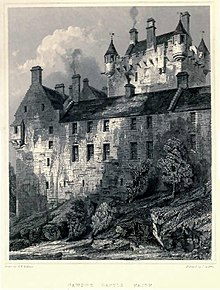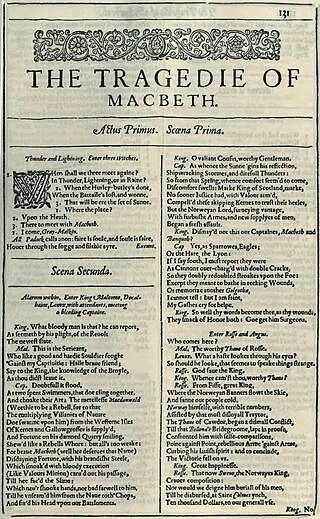
Macbeth is a tragedy by William Shakespeare. It is thought to have been first performed in 1606. It dramatises the damaging physical and psychological effects of political ambition on those who seek power. Of all the plays that Shakespeare wrote during the reign of James I, Macbeth most clearly reflects his relationship with King James, patron of Shakespeare's acting company. It was first published in the Folio of 1623, possibly from a prompt book, and is Shakespeare's shortest tragedy.

Glamis Castle is situated beside the village of Glamis in Angus, Scotland. It is the home of the Earl of Strathmore and Kinghorne, and is open to the public.

Clan Campbell is a Highland Scottish clan, historically one of the largest and most powerful of the Highland clans. The Clan Campbell lands are in Argyll and within their lands lies Ben Cruachan. The chief of the clan became Earl of Argyll and later Duke of Argyll.
Glamis is a small village in Angus, Scotland, located 5 miles (8 km) south of Kirriemuir and 5 miles (8 km) southwest of Forfar. It is the location of Glamis Castle, the childhood home of Queen Elizabeth the Queen Mother.
Cawdor is a village and parish in the Highland council area, Scotland. The village is 5 miles south-southwest of Nairn and 12 miles east of Inverness. The village is in the Historic County of Nairnshire.

Loudoun Castle is a ruined country house nicknamed the "Windsor of Scotland" located near Galston, in the Loudoun area of Ayrshire, Scotland. The majority of the building was constructed from 1804 to 1811 around existing structures dating to the 15th and 17th centuries. The building was destroyed by fire in 1942 and never rebuilt, while the rest of the property was converted into the Loudoun Castle theme park in 1995 and closed in 2010. The ruins are protected as a category A listed building.
Colin Robert Vaughan Campbell, 7th Earl Cawdor, DL is a Scottish peer, landowner, and architect. A member of the House of Lords from 1993 to 1999, he is Vice-Lord Lieutenant of Nairnshire.
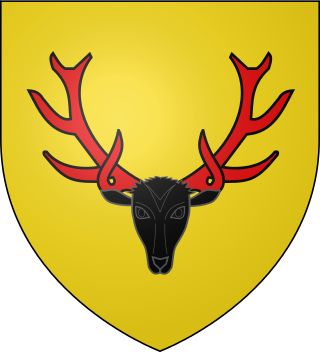
Clan Calder is a Highland Scottish clan. The clan is recognised by the Lord Lyon King of Arms but as it does not currently have a clan chief it is therefore considered an armigerous clan.
Thane of Cawdor is a title in the Peerage of Scotland. The current 7th Earl Cawdor, of Clan Campbell of Cawdor, is the 25th Thane of Cawdor.
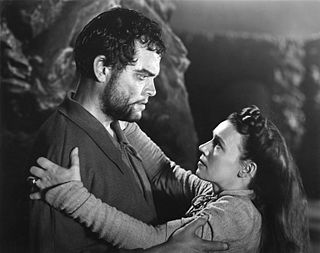
Lord Macbeth, the Thane of Glamis and quickly the Thane of Cawdor, is the title character and main protagonist in William Shakespeare's Macbeth. The character is loosely based on the historical king Macbeth of Scotland and is derived largely from the account in Holinshed's Chronicles (1577), a compilation of British history.
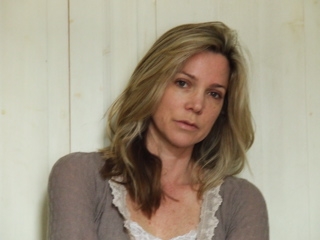
Lady Elizabeth Campbell, known professionally as Liza Campbell, is a Scottish artist, calligrapher, columnist, and writer. She is the second daughter of Hugh Campbell, 6th Earl Cawdor (1932–1993), by his first wife, the former Cathryn Hinde. She is the last child of an Earl Cawdor to have been born at Cawdor Castle, which has previously been erroneously associated with Shakespeare's Macbeth. Campbell was raised in Cawdor Castle during the Sixties, and studied art at Chelsea. She lived in Mauritius, Kenya (Nairobi) and in Indonesia between 1990 and 1996.
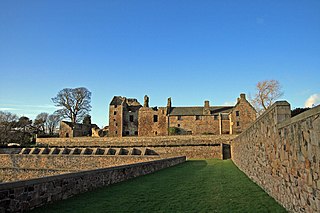
Aberdour Castle is in the village of Easter Aberdour, Fife, Scotland. Parts of the castle date from around 1200, making Aberdour one of the two oldest datable standing castles in Scotland, along with Castle Sween in Argyll, which was built at around the same time.

Clan Campbell of Cawdor is a highland Scottish clan and a branch of the larger Clan Campbell. While the clan is recognised by the Standing Council of Scottish Chiefs, the clan does not have a clan chief recognised by the Standing Council of Scottish Chiefs. Also, because the clan does not have a clan chief recognised by the Lord Lyon King of Arms it is considered an armigerous clan. The head of the Clan Campbell of Cawdor is the Earl Cawdor, currently held by Colin Campbell.
Thane was the title given to a local royal official in medieval eastern Scotland, equivalent in rank to the son of an earl, who was at the head of an administrative and socio-economic unit known as a thanedom or thanage.
Sir John Campbell was a Scottish nobleman and the eponymous ancestor of the Campbells of Cawdor.

Thane of Calder was a title of nobility in the Kingdom of Scotland.
Hugh John Vaughan Campbell, 6th Earl Cawdor, was a Scottish peer and landowner, a member of the House of Lords from 1970 until his death.
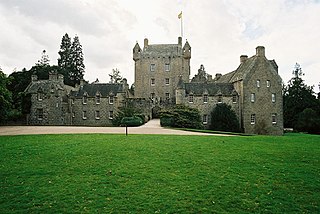
The Battle of Daltullich was a Scottish clan battle that took place in the autumn of 1499 at a place called Daltullich which is near to Strathnairn in the Scottish Highlands. It was fought between men of the Clan Calder and Clan Campbell. The heiress to the chiefship of the Clan Calder, Muriel, was carried away as agreed by men of the Clan Campbell to marry into the Campbell family, but they were pursued by her paternal uncles who tried to prevent this from happening.
This article collects the History of Nairn, Nairn is a town and Royal burgh in the Highland council area of Scotland. It is an ancient fishing port and market town around 17 miles (27 km) east of Inverness. It is the traditional county town of Nairnshire.
Angelika Campbell, Countess Cawdor, also known as Angelika Lažanská z Bukové a Chyše, is a Czech-British horticulturist, landowner and aristocrat. She is the second wife of the late Hugh John Vaughan Campbell, 6th Earl Cawdor.



